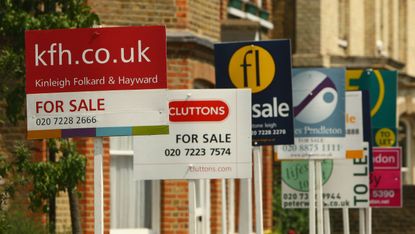The cooling housing market: what happens next for UK property?
The end of the latest boom is in sight. What kind of landing can we expect?

As we mark the Queen’s platinum jubilee, it’s fascinating to take a look at the economics of her whole 70-year reign, said David Smith in The Sunday Times. One story has been about inflation: her rule has been “bookended” by periods of rapid price rises in the early 1950s and early 2020s. But the biggest theme is “years of roaring house prices”. Back in 1952, when Nationwide helpfully began its house price index, the average UK home cost £1,891. The index’s latest average is £260,771 – “139 times the 1952 level”. This remarkable rise, fuelled by the greater availability of mortgages and inadequate housing supply, has had a huge social impact. “In the 1950s and 1960s, people did not need mega City salaries to live in style. Teachers, civil servants and other professionals could do so. Then housing pulled away.”
The pandemic led to another mini-boom, which outlasted the boost provided by extraordinary measures such as the stamp duty holiday. In March, Nationwide reported that prices had risen by 14.3% year-on-year. But the pace of growth now finally seems to be slowing, said Melissa Lawford in The Daily Telegraph. The latest survey from Zoopla indicates that “asking prices are being cut” – a sign that demand is falling and supply is rising – and “homes are also taking longer to sell”. The property website forecasts that by the end of the year, “the pace of growth will plunge to 3.4%”.
The big question, as ever, is whether boom is set to turn to ruinous bust – and the issue is playing out globally. The European Central Bank has warned that rising interest rates are likely to lead to “a correction” for eurozone house prices, which it judges to be “15% overvalued”, said Martin Arnold in the FT. Indeed, “a reversal in the region’s housing markets was one of the main risks identified by the ECB’s twice-yearly financial stability review”. Warnings from the US are even more alarming, said Paul Farrell in the Daily Mail. The former hedge fund boss Michael Burry, of The Big Short fame, has likened the slowing housing market to 2008. It’s like “watching a plane crash”, he said.
Subscribe to The Week
Escape your echo chamber. Get the facts behind the news, plus analysis from multiple perspectives.

Sign up for The Week's Free Newsletters
From our morning news briefing to a weekly Good News Newsletter, get the best of The Week delivered directly to your inbox.
From our morning news briefing to a weekly Good News Newsletter, get the best of The Week delivered directly to your inbox.
Experts are divided on where the market will go next. But despite “the psychological impact” of a rising base rate and the cost-of-living crisis, few predict a big fall this year or next, said Samantha Downes in The i Paper. As London estate agent Jeremy Leaf points out: “mortgage repayments remain relatively affordable”, and supply is still at “roughly half the level” it was pre-Covid. But even if a 90s-style crash is unlikely, “things could yet get a bit rocky”. Perhaps the best outcome would be for harsh economic conditions to “put some gentle brakes on the housing market”.
Create an account with the same email registered to your subscription to unlock access.
Sign up for Today's Best Articles in your inbox
A free daily email with the biggest news stories of the day – and the best features from TheWeek.com
-
 Nigeria's worsening rate of maternal mortality
Nigeria's worsening rate of maternal mortalityUnder the radar Economic crisis is making hospitals unaffordable, with women increasingly not receiving the care they need
By Harriet Marsden, The Week UK Published
-
 'Elevating Earth Day into a national holiday is not radical — it's practical'
'Elevating Earth Day into a national holiday is not radical — it's practical'Instant Opinion Opinion, comment and editorials of the day
By Harold Maass, The Week US Published
-
 UAW scores historic win in South at VW plant
UAW scores historic win in South at VW plantSpeed Read Volkswagen workers in Tennessee have voted to join the United Auto Workers union
By Peter Weber, The Week US Published
-
 6 serene homes in Vermont
6 serene homes in VermontFeatures Featuring a four-level Shaker barn in Hartland and a Scandinavian-inspired home in Stowe
By The Week US Published
-
 Amanda Montell's 6 favorite books that will expand your knowledge
Amanda Montell's 6 favorite books that will expand your knowledgeFeature The linguist recommends works by Mary Roach, Alice Carrière, and more
By The Week US Published
-
 Rowan Beaird recommends 6 compelling books from the 1950s
Rowan Beaird recommends 6 compelling books from the 1950sFeature The author recommends works by Patricia Highsmith, Shirley Jackson, and more
By The Week US Published
-
 6 spacious homes with great rec rooms
6 spacious homes with great rec roomsFeature Featuring a suspended fireplace in Arizona and a marine-themed home in Maine
By The Week Published
-
 Recipe: gnocchi di spinaci (spinach gnocchi)
Recipe: gnocchi di spinaci (spinach gnocchi)The Week Recommends Forget the potatoes for this gnocchi made of the 'classic combination' of spinach and ricotta
By The Week UK Published
-
 Why baby boomers and retirees are ditching Florida for Appalachia
Why baby boomers and retirees are ditching Florida for AppalachiaThe Explainer The shift is causing a population spike in many rural Appalachian communities
By Justin Klawans, The Week US Published
-
 Stephen Graham Jones' 6 scary books with deeper meanings
Stephen Graham Jones' 6 scary books with deeper meaningsFeature The best-selling author recommends works by Stephen King, Sara Gran, and more
By The Week US Published
-
 6 stylish homes on the top floor
6 stylish homes on the top floorFeature Featuring a 1925 art deco high-rise in San Francisco and a factory-turned-home in Los Angeles
By The Week US Published